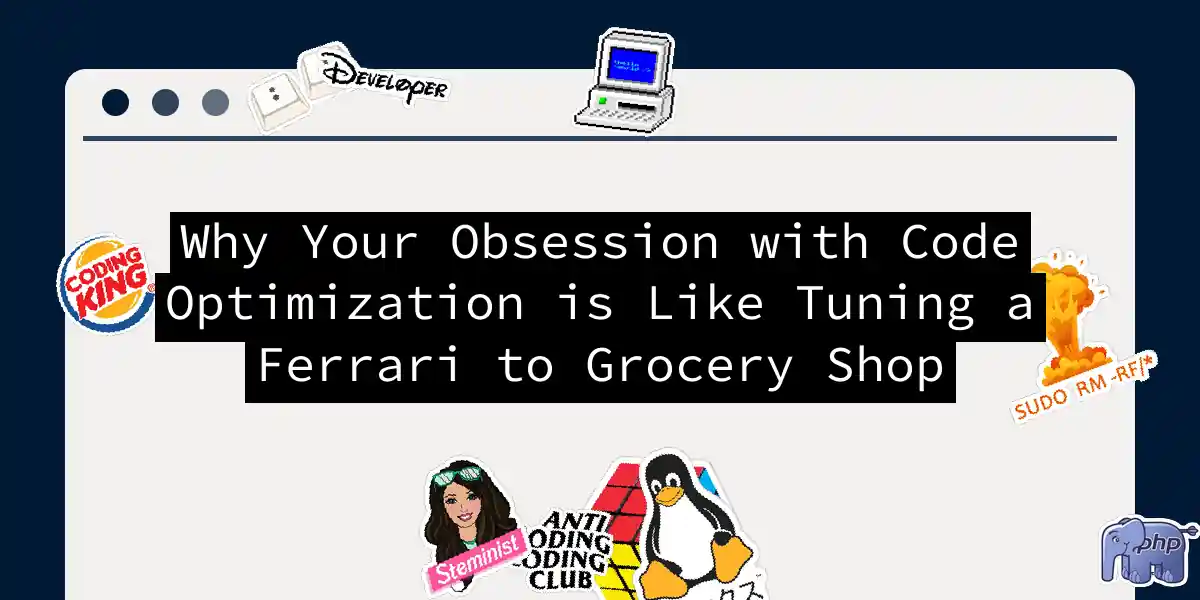Picture this: You’re in a code review, casually sipping your fourth coffee of the morning, when someone drops this gem: “Why use a list comprehension here? Dictionary lookups are O(1)!” Meanwhile, the method in question handles three items max. Congratulations - you’ve just witnessed premature optimization in its natural habitat.
The High Cost of Early Optimization
Let’s start with a horror story you might recognize:
# The "Optimized" Approach
results = []
for i in range(0, len(data), 1):
temp = process(data[i])
results.append(temp)
# vs The "Inefficient" List Comprehension
[process(x) for x in data]
I recently saw a developer argue for 20 minutes that the first approach was “more memory efficient.” For a script that runs once a month. For a dataset smaller than your Twitter DMs. The kicker? They were technically right - and completely wrong.
This isn’t just about clean code - it’s about survival economics. Every minute spent micro-optimizing is a minute not spent:
- Writing tests (you are writing tests, right?)
- Handling edge cases
- Preventing the next “404 Catastrophe” in prod
When Good Optimizations Go Bad
Let’s autopsy some classic “optimizations” I’ve found in PRs: The Loop Unrolling Epidemic
// Before
for (let i = 0; i < 4; i++) {
process(i);
}
// After "Optimization"
process(0);
process(1);
process(2);
process(3);
Because clearly, saving 3 loop iterations justifies 4x the code! 🎉
The Cache Cult
I once saw a developer implement a custom LFU cache for… user avatar URLs. The kicker? The app already had HTTP caching headers.
The Billion Dollar If-Statement
Endless debates about:
if x is None: ...
# vs
if not x: ...
Meanwhile, the actual business logic had enough holes to strain pasta.
The Optimization Survival Guide
Here’s my field-tested checklist before considering optimizations:
- The 3am Test: If this code fails at 3am, will I care?
- The Scale Test: Does it handle 10x our current traffic?
- The Money Test: Could this save actual dollars? (Spoiler: AWS bills > coffee money)
- The Friday Test: Will this make the Friday deploy riskier? When you do need to optimize, here’s how to not screw it up:
# Step 1: Write It Simple
def calculate_stats(data):
return {
'avg': sum(data)/len(data),
'max': max(data)
}
# Step 2: Profile Like a Pro
# $ python -m cProfile your_script.py
# Step 3: Optimize ONLY hotspots
def calculate_stats(data):
total = 0
maximum = data
for num in data:
total += num
if num > maximum:
maximum = num
return {'avg': total/len(data), 'max': maximum}
Notice how we didn’t touch the code until we had proof it was slow? Magic.
The Optimization Sweet Spot
Let’s end with my favorite optimization story: A team spent weeks optimizing image compression, only to discover 60% of their load time came from… wait for it… unoptimized CSS delivery. The lesson? You can’t optimize what you don’t measure.
Next time you feel the optimization itch, ask yourself: Am I solving a real problem or just flexing my CS degree? Your future self (and your annoyed teammates) will thank you. Now if you’ll excuse me, I need to go rewrite this article in Assembly. Just kidding. (Or am I?) 🔥
